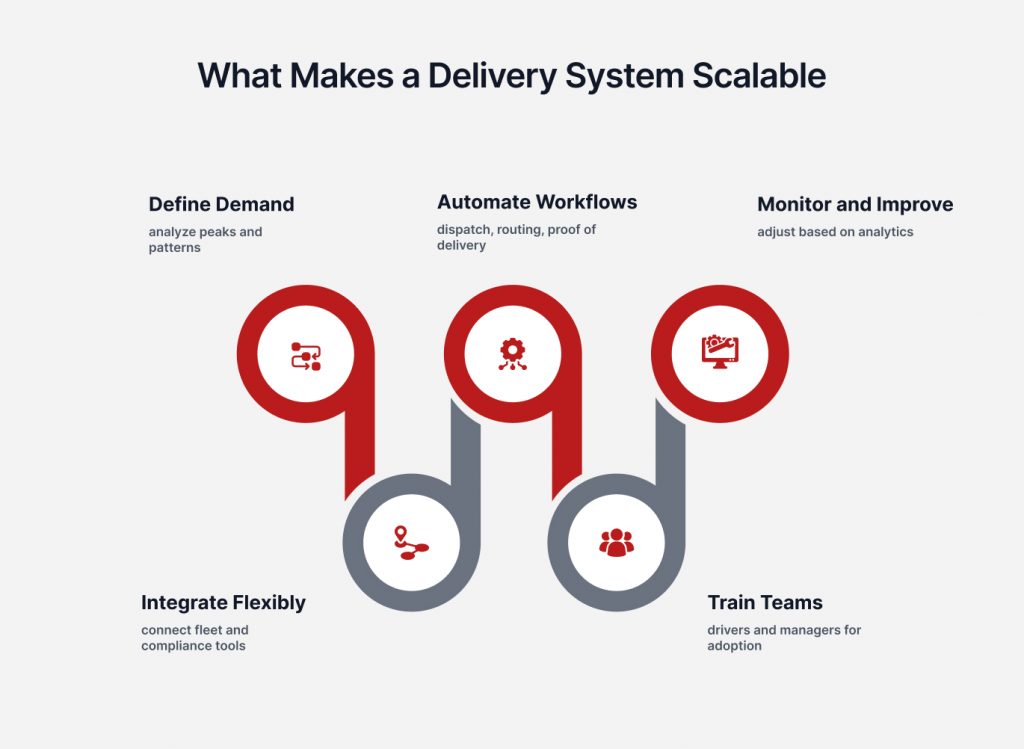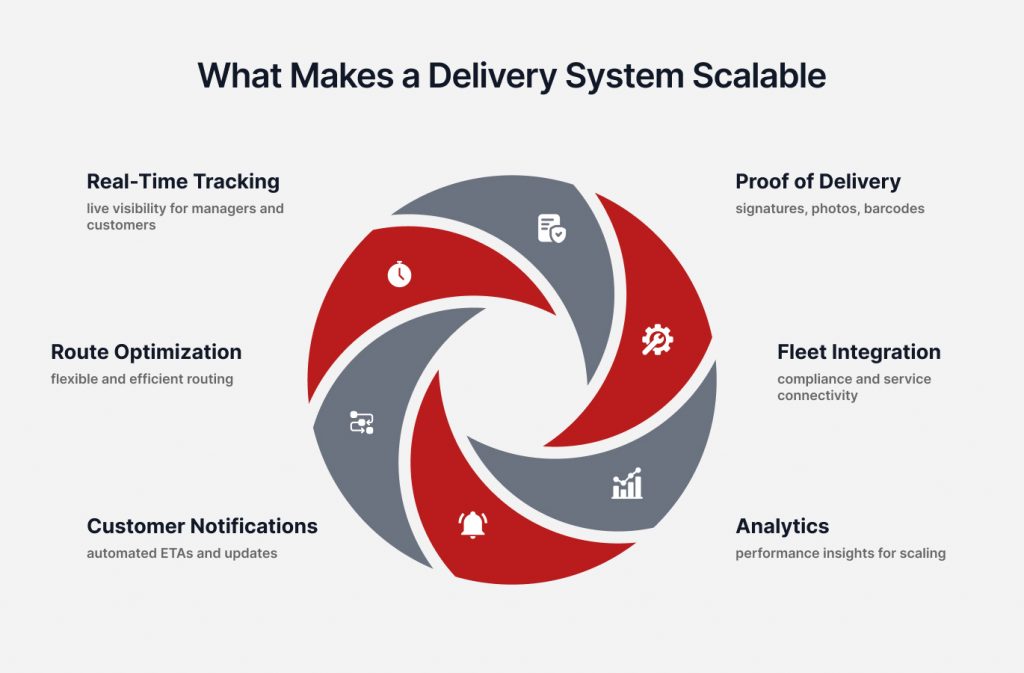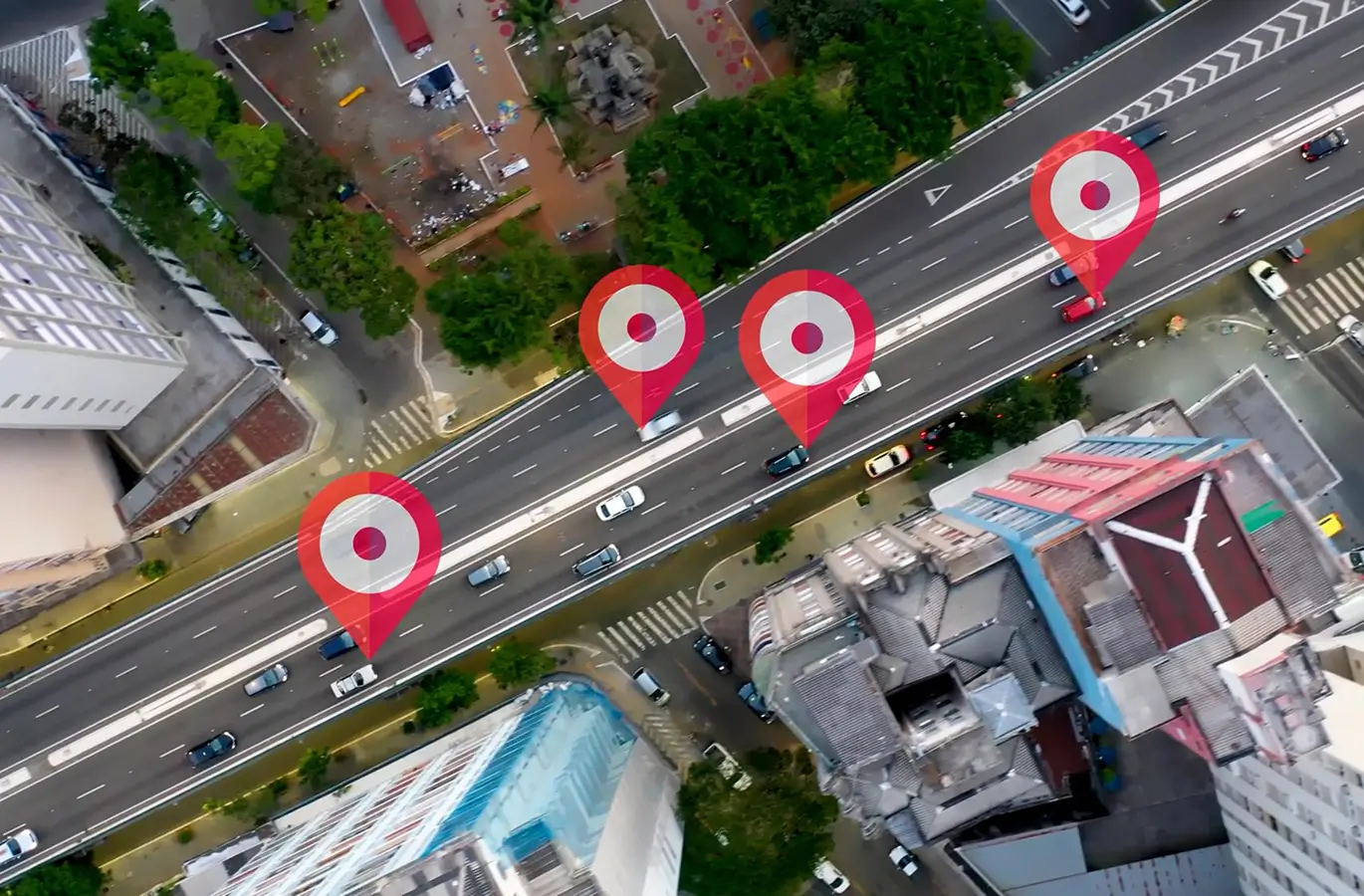The delivery industry is under constant pressure. Customers expect fast, transparent, and reliable service, while businesses face fluctuating demand that can rise sharply during peak seasons. For many fleets, the real challenge is not completing deliveries but scaling operations without sacrificing efficiency or customer satisfaction.
A delivery management system (DMS) solves this challenge by providing the structure fleets need to handle more orders, manage more routes, and serve more customers without losing control. Instead of relying on manual dispatching or fragmented tools, fleets gain a centralized platform that grows with demand.
In this article, we examine why scaling deliveries is challenging, what a delivery management system entails, and how to develop one that can adapt to rising demand. We also explain how REACH helps fleets transform delivery operations into a scalable and sustainable advantage.
The Challenge of Scaling Deliveries
Scaling delivery operations sounds straightforward. More orders come in, so more vehicles are dispatched. In reality, the process is fraught with complications that push fleets to their limits.
Rising Customer Expectations
Customers no longer accept vague delivery windows. They want accurate ETAs, live tracking, and proactive notifications in case of delays. Meeting these expectations requires systems that provide real-time visibility and seamless communication.
Fluctuating Demand
Demand is rarely steady. Seasonal spikes, promotional campaigns, or unexpected surges create pressure on fleets. Without scalable systems, managers scramble to allocate vehicles, assign routes, and balance workloads.
Strain on Resources
Scaling often exposes inefficiencies in resource management. Drivers face longer routes, vehicles undergo more wear and tear, and maintenance schedules get disrupted. When operations depend on manual coordination, these strains quickly turn into delays and downtime.
Operational Bottlenecks
Manual or outdated delivery systems struggle with scheduling, dispatching, and proof-of-delivery processes. As volume grows, errors multiply, communication breaks down, and customer trust declines.
The result is a cycle of inefficiency: more demand creates more stress, which leads to delays and dissatisfied customers. Without a scalable delivery management system, fleets risk losing both revenue and reputation.
What is a Delivery Management System (DMS)
A delivery management system (DMS) is a digital platform that manages the planning, execution, and tracking of deliveries from start to finish. It is more than just GPS tracking or dispatching software. A true DMS integrates routing, real-time visibility, communication, and proof of delivery into a single workflow that scales with business growth.
Definition and Purpose
The purpose of a DMS is to ensure that every delivery is completed on time, tracked accurately, and communicated clearly to both customers and managers. It serves as a central hub, connecting orders, vehicles, drivers, and customers.
Core Functions of a DMS
Routing and Scheduling
The system assigns deliveries to vehicles and drivers, optimizing routes for speed and efficiency.
Live Delivery Tracking
Managers and customers can see the real-time status of each order. This transparency reduces uncertainty and improves trust.
Proof of Delivery
Drivers capture digital signatures, photos, or barcodes that confirm deliveries. These records protect fleets against disputes.
Communication Tools
Automated notifications keep customers updated on ETAs, delays, or successful deliveries. This proactive communication reduces inbound customer service calls.
Analytics and Reporting
A DMS generates insights into delivery times, driver performance, and route efficiency. Managers can use these reports to refine operations and scale effectively.
Why It Matters Beyond Tracking
While GPS tracking shows where vehicles are, a DMS takes it a step further by connecting that location data to delivery workflows. It informs managers not only of a vehicle’s location but also whether the order is on schedule, whether customers have been notified, and whether proof of delivery has been obtained. This integration is what makes the system scalable.
Features That Enable Scalability
A delivery management system becomes valuable when it can scale with demand without breaking operations. This requires features that go beyond basic dispatching. Scalable systems are designed to handle fluctuating order volumes, manage diverse fleets, and maintain a high standard of customer service even during periods of peak demand.
Real-Time Tracking and Transparency
Live tracking is the backbone of scalability. Managers are aware of the location of each vehicle, the progress of deliveries, and whether routes are on schedule. Customers also benefit from real-time visibility, which reduces uncertainty and increases satisfaction.
Route Flexibility and Optimization
Scalable systems must adjust routes in real time. If traffic, weather, or last-minute changes occur, managers can reroute drivers instantly. Automated optimization enables vehicles to complete more deliveries with fewer miles, resulting in both time and fuel savings.
Customer Notifications and ETAs
As delivery volumes increase, manually updating customers becomes impossible to manage. A DMS sends automated notifications with accurate ETAs and alerts for delays. This proactive communication builds trust and reduces pressure on customer service teams.
Proof of Delivery
Digital proof of delivery provides accountability on a large scale. Signatures, photos, or barcode scans confirm that each order was completed. These records protect the fleet against disputes and provide managers with a clear history of deliveries.
Integration with Fleet Operations
Scalability requires more than delivery visibility. A strong DMS integrates with compliance tools, service schedules, and fleet tracking systems. This ensures that vehicles not only deliver but also remain road-ready and compliant.
Analytics for Continuous Improvement
Scaling is not just about handling more deliveries, but also about handling them more effectively. Analytics enable managers to identify bottlenecks, measure performance, and refine their strategies. Over time, these insights enable the system to adapt and grow in response to demand.
Core Features of a Scalable Delivery Management System

How to Build a Delivery Management System That Scales
A delivery management system becomes truly valuable when it is designed with scalability in mind from the start. Building such a system requires more than software installation. It involves aligning processes, technology, and people to ensure the system adapts to rising demand without disruption.
Step 1: Define Demand Patterns and Peak Periods
Before implementing a DMS, fleets should analyze demand trends. Understanding seasonal spikes, regional differences, and customer expectations helps shape the system so it can handle peak loads without breaking under pressure.
Step 2: Choose Flexible Integrations
A scalable system must integrate easily with existing hardware, fleet tracking tools, and compliance workflows. Flexibility ensures that as fleets expand, new vehicles, devices, and software connect seamlessly without requiring a full rebuild.
Step 3: Automate Core Workflows
Dispatch, routing, proof of delivery, and customer notifications should all be automated. This reduces human error, cuts manual workload, and ensures consistency across growing volumes of deliveries.
Step 4: Train Teams for Adoption
Drivers, dispatchers, and managers need clear training to use the system effectively. Adoption improves when teams see how the system makes their work easier, not harder. Continuous support keeps usage high.
Step 5: Monitor Performance and Adjust
Scalability is not static. Fleets should track delivery times, route efficiency, and customer satisfaction through analytics dashboards to optimize their operations and improve overall performance. Reviewing these metrics helps identify weak points and refine processes as demand evolves.
Steps to Build a Scalable Delivery System

Benefits of a Scalable DMS
Building a delivery management system that scales is not just about handling more orders; it’s also about efficiently managing existing ones. It is about doing so in a way that reduces strain on resources, keeps costs under control, and delivers a consistent customer experience. A scalable DMS turns growing demand into an opportunity rather than a burden.
Fewer Delays During Demand Surges
When order volumes rise suddenly, fleets without scalable systems face late deliveries, scheduling chaos, and unhappy customers. A scalable DMS absorbs these surges by automating dispatch, rerouting vehicles in real time, and notifying customers proactively. This ensures demand spikes do not turn into service failures.
Higher Customer Satisfaction
Transparency is now a baseline expectation. A scalable DMS provides real-time tracking, accurate ETAs, and instant proof of delivery. Customers gain confidence knowing they can monitor progress and rely on updates. This reliability builds long-term trust.
Improved Resource Utilization
Instead of adding more vehicles or staff during peak periods, a scalable system helps fleets do more with what they already have. Route optimization reduces empty miles, scheduling balances workloads, and automated workflows free up staff time for higher-value tasks.
Lower Operational Costs
Scaling without structure often means wasted fuel, overtime pay, and costly last-minute fixes. A scalable DMS reduces these expenses by streamlining operations, identifying inefficiencies early, and optimizing the use of fleet assets.
Stronger Data Insights
Analytics built into a DMS reveal where fleets excel and where they fall short. Managers can identify bottlenecks, track driver performance, and measure customer satisfaction. These insights support continuous improvement and smarter scaling decisions.
Competitive Advantage
In markets where multiple fleets compete for contracts, scalability becomes a selling point. A business that consistently delivers on time, even during periods of high demand, stands out as a reliable partner. Over time, this capability translates into stronger client relationships and more growth opportunities.
Why REACH Powers Scalable Delivery
Scaling deliveries requires a system that is practical, flexible, and designed to handle complexity without overwhelming users. REACH meets these needs by combining fleet visibility, compliance readiness, and customer-facing transparency into a single platform. It helps fleets move beyond basic tracking and into true delivery management that grows with demand.
Hardware-Agnostic Flexibility
REACH connects with a wide range of devices, from plug-and-play GPS units to advanced trackers. This flexibility ensures that fleets can scale without being tied to a single type of hardware. As new vehicles are added, they integrate seamlessly into the system.
Live Location with Delivery Context
While many systems offer GPS tracking, REACH ties live location to delivery workflows, allowing managers to see not only where vehicles are but also which deliveries are in progress, which have been completed, and which require attention. This clarity keeps scaling operations under control.
Service and Compliance Integration
A delivery system cannot succeed if vehicles are off the road due to compliance issues or downtime. REACH connects delivery management with service tracking and compliance tools. Vehicles remain road-ready, and digital, timestamped records support audits.
Automated Workflows
From inspection-triggered service requests to customer notifications, REACH automates processes that would otherwise slow down scaling. Drivers, dispatchers, and managers spend less time on manual updates and more time ensuring deliveries are completed on time.
Customer Trust Through Transparency
REACH enables fleets to share accurate ETAs and real-time updates with customers. This transparency reduces the need for support calls and strengthens trust, especially during demand surges when reliability is crucial.
ROI That Grows With Scale
By cutting downtime, reducing inefficiencies, and improving delivery reliability, REACH delivers measurable ROI. The more fleets scale, the more value the platform provides, making growth sustainable rather than stressful.
Why It Matters in 2026
Delivery demand will only continue to rise. Fleets that rely on outdated tools will struggle to keep up, while those with scalable systems will thrive. REACH equips fleets with the flexibility, reliability, and transparency needed to grow confidently in today’s competitive delivery landscape.
Designing Delivery for Growth
Scaling delivery operations is no longer optional. Customers expect speed, accuracy, and transparency, while demand patterns continue to shift unpredictably. Fleets that rely on manual processes or basic tracking struggle to keep pace, leading to delays, higher costs, and a loss of trust.
A delivery management system built for scalability changes this. By integrating routing, live tracking, proof of delivery, and analytics into a single platform, fleets can effectively handle rising demand without compromising service quality. The result is fewer delays, greater efficiency, and stronger customer relationships.
REACH makes this vision practical. With hardware flexibility, compliance-first design, and automation that connects drivers, managers, and customers, it transforms delivery management into a system that grows alongside demand. Fleets using REACH not only scale smoothly but also gain a competitive advantage in reliability and trust.
The future of delivery belongs to fleets that can grow without breaking their operations. A scalable delivery management system is the foundation that makes it possible.
Key Takeaways
- Scaling delivery is challenging without the right tools due to rising expectations and fluctuating demand.
- A delivery management system centralizes routing, tracking, communication, and proof of delivery.
- Scalable features include real-time visibility, route flexibility, automated notifications, and analytics.
- Building a scalable system requires thorough demand analysis, flexible integrations, automation, effective training, and regular performance reviews.
- Benefits include fewer delays, higher customer satisfaction, improved resource utilization, and lower costs.
- REACH enables scalable delivery by combining fleet visibility, compliance, and customer-facing transparency into one platform.
Frequently Asked Questions (FAQs)
-
What is a delivery management system?
A delivery management system is a digital platform that manages the planning, execution, and tracking of deliveries. It integrates routing, real-time tracking, proof of delivery, and analytics to improve efficiency and customer satisfaction.
-
Why do fleets need a scalable delivery management system?
Without scalability, fleets struggle during peak demand. A scalable DMS handles fluctuating order volumes, manages resources more efficiently, and ensures on-time deliveries even when demand surges.
-
What features make a delivery management system scalable?
Key features include real-time tracking, flexible routing, automated customer notifications, proof of delivery, fleet compliance integration, and analytics for continuous improvement.
-
How does a delivery management system improve customer experience?
Customers gain transparency with accurate ETAs, proactive notifications, and real-time tracking. Proof of delivery adds accountability, which in turn builds trust and enhances retention.
-
What is the difference between delivery management and simple GPS tracking?
GPS tracking shows the location of vehicles, while a DMS connects that data to workflows such as dispatching, proof of delivery, and customer updates. This makes it scalable and actionable.
-
How does REACH support scalable delivery management?
REACH integrates delivery tracking with compliance and service management, automates workflows, and provides live visibility for both managers and customers. This makes it easier for fleets to scale without losing control.



